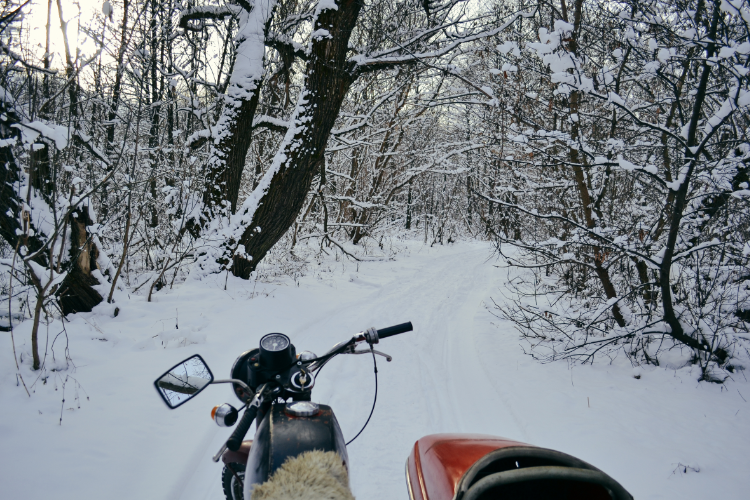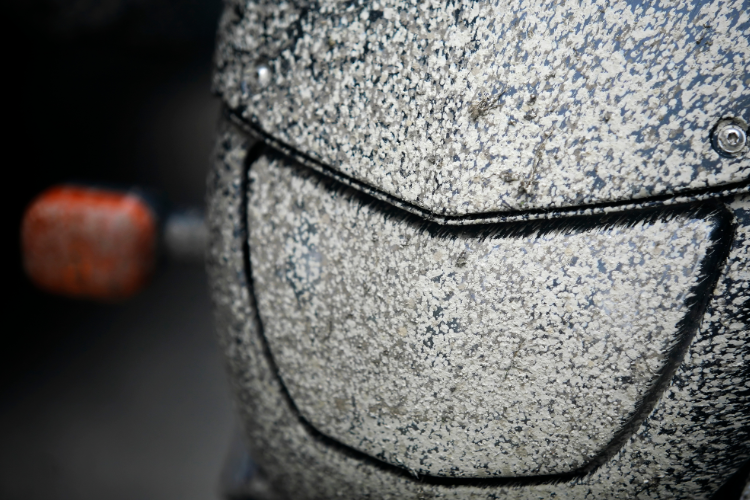This guide will walk you through everything you need to know about motorcycle winter storage, from preparing fluids to ensuring your bike is shielded from the elements. With these easy steps, you’ll keep your bike in top condition and avoid common storage mistakes.
Let’s dive into how to prepare your motorcycle for winter and the best practices for maintaining it throughout the colder months.
Key Takeaways:
- During the winter, many motorcyclists store their bikes for the season to protect them from the elements.
- Proper preparation and winterization of your motorcycle ensures it remains in top condition. Key steps for motorcycle storage include checking tires and giving all metal and rubber parts a good cleaning.
- A storage unit, garage, or shed are all indoor winter motorcycle storage options. Outdoor motorcycle parking with a proper cover may be suitable for bike owners in temperate climates.
In This Guide:
- Winterizing a Motorcyle
- Common Errors of Winter Storage
- Help with Motorcyle Winter Storage
- Motorcycle Winter Storage FAQs
Winterizing a Motorcycle

Winterizing your motorcycle ensures it stays in top shape during the off-season. Proper preparation includes freshening up the fluids, checking the tires, and protecting components from moisture and cold.
By following a winterization checklist, you’ll prevent engine issues, battery failure, and rust buildup. Below, we’ll explore key steps you can take to fully winterize your bike and avoid any springtime surprises.
Do you have both a car and a motorcycle? Make sure to read our guide on how to winterize your car.
Freshen up Fluids
Before storing your motorcycle for the winter, it’s essential to refresh and top off all necessary fluids. Start by adding a fuel stabilizer to the gas tank to prevent the fuel from degrading and causing engine trouble. Don’t forget to check the coolant and brake fluid levels to ensure they’re at optimal levels.
This helps to prevent freezing and corrosion over the winter months. Make sure to flush and replace old fluids as necessary, as stagnant fluids can damage internal components. Properly managing your fluids ensures your bike will be ready for a smooth start come spring.
Check Tires
Tire maintenance is crucial before storing your motorcycle. Start by inspecting the tire pressure, as cold temperatures can cause the air inside to contract, leading to underinflated tires. Flat spots can develop if the bike sits in one position for too long, so it’s best to inflate the tires to the manufacturer’s recommended PSI.
For added protection, you may want to invest in a motorcycle stand to lift the tires off the ground, preventing flat spots and maintaining tire integrity during the winter.
Change the Oil
Before putting your motorcycle in winter storage, it’s highly recommended to change the oil. Old oil can contain contaminants like dirt, moisture, and metal particles, which can lead to corrosion and engine damage when left sitting in the system for long periods.
Drain the used oil and replace it with fresh oil to ensure that the engine components remain lubricated and protected during storage. By starting the season with clean oil, you’ll help extend the lifespan of your engine and avoid unnecessary wear.
Tenderize the Battery
The cold winter months can take a toll on your motorcycle’s battery, potentially draining it if not properly maintained. A battery tender or trickle charger is a simple and effective way to keep your battery charged during winter storage.
Simply connect the tender to your battery terminals, and it will provide a steady flow of electricity to maintain an optimal charge. This prevents your battery from dying over the winter and ensures that it’s ready to go when the riding season begins again.
Wash the Bike
Before putting your motorcycle into winter storage, give it a thorough wash to remove dirt, grime, and any road salt that may have accumulated. Failing to clean the bike can lead to corrosion and rust, especially if contaminants are left on the surface during the winter months.
Pay special attention to areas prone to rust, like the exhaust and chain. After washing, make sure the bike is completely dry to avoid moisture buildup during storage. A clean bike will emerge from winter storage looking fresh and damage-free.
Wax the Chain
Lubricating and waxing your motorcycle’s chain before storage is a must to prevent rust and corrosion. Once the bike is clean and dry, apply a quality chain lube or wax to the entire chain, ensuring even coverage.
This creates a protective barrier that shields the chain from moisture and rust, particularly during the cold and damp winter months. A properly maintained chain ensures better performance and longevity, so you can hit the road with confidence when spring rolls around.
Prep Exhaust Pipe
To avoid moisture buildup and potential rust inside your exhaust pipe, it’s important to prep it before storing your motorcycle. A simple way to do this is by covering the exhaust pipe opening with a plastic bag or exhaust plug.
This prevents moisture from entering and causing rust or corrosion inside the pipe. You can also spray a rust inhibitor inside the pipe for extra protection. Taking these small precautions will save you from dealing with rust damage and expensive repairs when the riding season resumes.
Inspect Belt Drive
If your motorcycle uses a belt drive, inspect it closely for signs of wear or damage before storage. Cold weather can cause the belt to become brittle, so make sure it’s properly lubricated and free of cracks or fraying. Tighten or adjust the tension as necessary to prevent any issues during storage.
Additionally, you may want to cover the drive to protect it from dust and moisture. A well-maintained belt drive ensures smooth power transmission when your bike is back in action.
Use a Cover
Investing in a high-quality motorcycle cover is essential for winter storage. A breathable, waterproof cover will protect your bike from dust, moisture, and temperature fluctuations, which can cause rust and damage over time.
Ensure that the cover fits snugly around the bike to prevent dirt and moisture from seeping in. Avoid using a cheap cover, especially one made out of plastic, as it can trap moisture and lead to condensation buildup. With a proper cover, your motorcycle will stay protected from the elements during the off-season.
Store in a Cool, Dry Place
Where you store your motorcycle during the winter is just as important as how you prepare it. Choose a cool, dry place like a garage, basement, or storage unit that protects the bike from moisture and extreme temperature changes.
If you don’t have access to indoor storage, consider renting a space or using a weatherproof shed. Make sure the bike is elevated off the ground to prevent moisture damage. Storing in a controlled environment, such as a storage unit, ensures that your bike remains in excellent condition until you’re ready to ride again.
Common Errors of Winter Storage

Storing a Dirty Bike
According to Harley-Davidson, one of the most common mistakes is storing a dirty motorcycle. Dirt, grime, and road salt can cause rust and corrosion when left on the bike for extended periods, especially in cold, damp conditions.
Always wash your bike thoroughly before storage to avoid unnecessary damage and ensure it’s ready for the next riding season.
Leaving Fluids in the Fuel Tank
Another frequent error is leaving old fuel in the tank without adding a stabilizer. Over time, gasoline can degrade and lead to gumming in the fuel system, which can cause engine problems. Always add a fuel stabilizer to prevent the fuel from breaking down during storage and protect the engine.
Not Starting Your Bike Each Week
Many riders forget to start their motorcycle regularly during storage. Allowing your bike to sit for months without starting can lead to battery drainage and mechanical issues. Start the bike at least once a week to keep the engine in good condition and prevent any potential problems when it’s time to ride again.
Help with Motorcycle Winter Storage
Need to transport your bike to have it stored for the winter? Let Sherpa Auto Transport, the leader in nationwide vehicle shipping, bring your bike to its cold-weather destination. We provide top-notch motorcycle shipping solutions including enclosed trailers and door-to-door service. Submit a quote online or call our team today at (877) 850-1231.
Motorcycle Winter Storage FAQs
Should I have insurance if I don’t ride in the winter?
Yes, it’s advisable to keep insurance coverage on your motorcycle even during the winter months. Some insurers offer reduced rates for off-season storage, but maintaining coverage can protect your bike from theft, vandalism, or damage.
Maintaining insurance is also recommended to enjoy winter riding on unseasonably warm days.
How much does it cost to store a motorcycle?
The cost of storing a motorcycle varies based on location and facility type. On average, you can expect to pay between $50 to $150 per month for an indoor storage unit. If you opt for a climate-controlled facility, the price may be higher but will provide better protection.
How do I ship my motorcycle if I move?
If you’re moving and need to ship your motorcycle, hiring a professional transport service like Sherpa Auto Transport ensures safe and reliable shipping. We offer door-to-door delivery, enclosed transport options, and comprehensive insurance coverage, giving you peace of mind during the move.
When do you winterize a motorcycle?
The best time to winterize your motorcycle is just before you are set to experience freezing temperatures. This ensures your bike is fully prepared for cold weather conditions and minimizes the risk of damage during storage.







